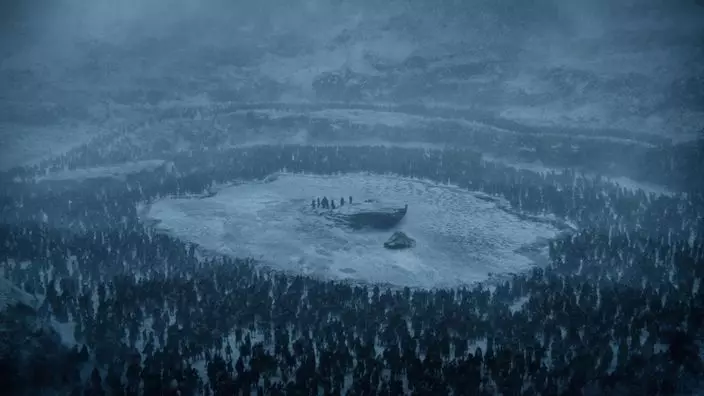It was dragons vs. zombies in fiery combat during this week's "Game of Thrones," a battle that likely provides just a hint of what lies ahead in HBO's hit series.
Yet the epic scene also raised an economic question: Can the White Walkers' command-and-control economy defeat their disorganized, squabbling Westerosi opponents?
The Associated Press' economics team explores this question, as well as the growing rivalry between sisters Sansa and Arya Stark, in the latest episode of our audio series, "The Wealth of Westeros." We were joined by Carolyne Larrington , a professor of medieval English literature at Oxford.

This photo provided by HBO shows a scene from the sixth episode of the seventh season of HBO's "Game of Thrones." Dragons fought zombies in a thunderous battle on “Game of Thrones” on Sunday, Aug. 20, 2017, a showdown that provides just a hint of what likely lies ahead in the show’s final season. Yet the battle also raised an economic question: Can the White Walkers' command and control economy defeat their disorganized, squabbling Westerosi opponents? (Courtesy of HBO via AP)
The icy, humanoid White Walkers have mobilized a fearsome, unthinking army of zombies against the population of Westeros, the Europe-like continent where the show mostly takes place. Their top-down, centralized approach can be intimidating from a military perspective. It can also help an economy accelerate temporarily, as the Soviet Union's did after World War II.
But this week's episode provides clues about the shortcomings of this approach. When a White Walker is killed by Jon Snow, all the zombies created by that White Walker also die off.
In other words, in a system with no individual autonomy or decision-making, the White Walker army is useless without its leaders.
By contrast, Jon Snow, Daenerys Targaryen and their compatriots bicker incessantly about strategy, but their less-centralized approach allows individuals like Snow to take risks and make their own decisions. Historically, economies that allow entrepreneurs to do the same have provided greater prosperity than those run from the top down.
Some other highlights from this week's show:
— SISTERLY RIVALRY GETS OUT OF HAND
One surprise this season has been the growing suspicion and ill-will between Sansa and Arya Stark. Both have suffered terribly after their mother and oldest brother were killed at the infamous "Red Wedding," and the scars they bear seem to be pushing them further apart.
This week, Arya attacks Sansa for a letter she wrote — against her will — years earlier, urging her older brother, Robb, to pledge his loyalty to the spoiled, evil King Joffrey.
Larrington, who wrote a book titled "Brothers and Sisters in Medieval European Literature," as well as "Winter Is Coming: the Medieval World of Game of Thrones," said the conflict is unusual for its time, because it doesn't involves a romantic rivalry.
"When sisters fall out in traditional stories like this, it's usually over a man," she said. "They both want the same man," but that's not true in this case.
"It's not like they both want Littlefinger, I mean God forbid," Larrington added. "They're not going to predestined paths like most medieval women would have done, which is getting married at quite a young age. They are actually fighting for power, fighting for self-determination, and it has cost both of them quite a lot."
WINTER IS COMING — AND SO IS CLIMATE CHANGE?
The show's catchphrase, "Winter Is Coming," refers to both the harsh, extended winters that can last for years in Westeros as well as the White Walker invasion. It's long been seen as a metaphor for climate change.
Just like climate change, the threat is two-fold: The people of Westeros have to figure out how to defeat the White Walkers, and also how to convince many of their compatriots that the threat is real.
In "Game of Thrones," the White Walkers haven't appeared for thousands of years, so it's not surprising that many characters on the show regard them as myths.
But even with all our advances in science and communications, it's still difficult to achieve consensus in the United States — and globally — on whether global warming constitutes a serious threat.
DRAGON V. DRAGON
The White Walkers now have their own zombie dragon, after killing one of Daenerys's dragons and capturing its corpse. This raises an interesting question of military strategy that has been studied by economists who specialize in game theory: Now that both sides have weapons of mass destruction, will they hold back from using them, as modern nuclear powers have done? Or will it increase the incentives for one side to strike first?
This is "Game of Thrones" we're talking about, so the safe answer is the latter one.










